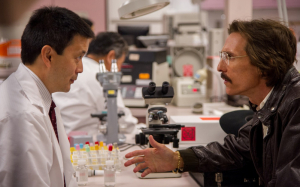“The Dallas Buyers Club” Takes on AIDS, Peer Patients, and Not Taking “No” for An Answer
If you’re a doctor or nurse of a certain age, the Dallas Buyers Club will jog memories. If you’re among those who lost a loved one or friend to AIDS maybe 20 or 30 years ago, or not, this new film might wrench your heart. Anyone watching will be pushed to think hard about drug development today, the slow pace of progress for metastatic breast cancer and other young life-takers, and the FDA’s role in sanctioning, or blocking, treatments for adults with terminal illness.

The movie draws loosely on the story of Ron Woodroof, a Texan rodeo rider who developed AIDS around 1985. A rail-thin Matthew McConaughey, who says he dropped nearly 50 pounds for this role, somehow nails the look of young, HIV-infected men who were filing into hospitals and clinics back then. After absorbing his diagnosis and said prognosis of 30 days to live, the cowboy teams up with Rayon, a (fictitious) transgender woman portrayed, memorably, by Jared Ledo. Together with an oddball group of sympathetic accomplices, the pair set up shop, to procure and distribute unapproved medications the doctors won’t prescribe. Jennifer Garner plays a sympathetic young physician, Dr. Eva Saks, who in the movie crosses lines a bit incredibly, too personally in the second half, to help the AIDS patients and commiserate. But otherwise the film is spot-on. It captures the desperation, determination and clinging together of people, then, affected by what was incurable disease.
One question that sticks with me, as a physician reflecting on the story, is how unclear it is which drugs, exactly, helped the protagonist. Woodroof, as depicted in the film, briefly takes AZT and then moves on to all kinds of substances including DDC (Zalcitabine) from Mexico, interferon of unknown purity or dose from Japan, protein supplements and more. Through a mix of stuff he lives until 1992, seven years beyond what the doctors first told him to expect. An old-school clinical trialist, almost any of my former teachers, and anyone who appreciates evidence-based medicine (as I do, for the record) would know and state and insist that you can’t draw any conclusions based on what happened to the movie’s protagonist, or Woodroof in real life.
On the other hand, clinical trials are painfully slow. Published trials can be flawed. Even if they’re randomized and well-analyzed, the findings can be hard to interpret when it comes to a single patient’s course and well-being. What’s a dying man to do?
Another relevant point, for people affected by almost any health problem, is the extent to which the patients took charge in the Dallas Buyers Club. They found and shared information about their disease independently of their physicians. The image of an AIDS patient using an old computer in a library, looking up articles about his condition, anticipates patient networks of which there are hundreds, on-line and in communities, today.
I came away from this movie feeling optimistic. Because when I was a student, 30 years ago, I wouldn’t have believed that a man afflicted by AIDS, as McConaughey portrays, could now, likely, live for a long time.
#hope, and happy Thanksgiving,
ES
My main wonder in these matters is the decision making process that leads to any investment in drugs because the primary motive of any company is – yes, profit! This brings about both good and bad outcomes, but one thing generally ignored by the media is that funding for aids seems to have stifled research for even bigger killers. Not I am NOT suggesting in any way or form that AID research should not be funded – I merely recognize that it only became funded largely because of media domination by by interested parties. The poor of the world have no such voice and so fall last in the queue. I’m not wise enough to have the answers, but I do think more animated discussion is needed on the matter of government and private funding for new drugs.